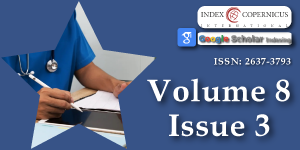Jaw Subluxation as a Complication of Tardive Dyskinesia
Main Article Content
Abstract
Tardive Dyskinesia (TD) is an iatrogenic complication caused by antipsychotic agents and rarely by other anti-depressive/antiepileptic or anti-nausea medication. It is mostly a benign condition with implications regarding esthetic issues but it can also impact social and emotional well-being. We are reporting a case in which severe TD ensued in an elderly lady with newly diagnosed dementia, who presented to the psychiatric ER with a Capgras syndrome and paranoia accompanied by behavioral disturbances. She was treated with 4 consecutive antipsychotic agents (haloperidol, brexiprazole, risperidone, and olanzapine) due to unresponsive psychosis in conjunction with biperiden and developed a severe case of TD, which was complicated by two successive episodes of jaw subluxation. In spite of the good outcome following the reduction of the subluxation, we emphasize the danger of this rare painful, and bothersome side-effect and recommend how to pharmacologically deal with the TD setting in which it occurred.
Article Details
Copyright (c) 2024 Kertesz DP.

This work is licensed under a Creative Commons Attribution-NonCommercial 4.0 International License.
Frei K, Truong DD, Fahn S, Jankovic J, Hauser RA. The nosology of tardive syndromes. J Neurol Sci. 2018;389:10-16. Available from: https://doi.org/10.1016/j.jns.2018.02.008
Diagnostic and Statistical Manual of Mental Disorders. Fifth Edition. DSM-5. Available from: https://seragpsych.com/wordpress/wp-content/uploads/2019/02/DSM5Update_October2018.pdf
Correll CU, Kane JM, Citrome LL. Epidemiology, Prevention, and Assessment of Tardive Dyskinesia and Advances in Treatment. J Clin Psychiatry. 2017;78(8):1136-1147. Available from: https://doi.org/10.4088/jcp.tv17016ah4c
Frei K. Tardive dyskinesia: Who gets it and why. Park Relat Disord. 2019;59(August 2018):151-154. Available from: https://doi.org/10.1016/j.parkreldis.2018.11.017
Kane JM. Tardive dyskinesia in affective disorders. J Clin Psychiatry. 1999;60 Suppl 5:43-7; discussion 48-9. Available from: https://pubmed.ncbi.nlm.nih.gov/10192407/
Solmi M, Pigato G, Kane JM, Correll CU. Clinical risk factors for the development of tardive dyskinesia. J Neurol Sci. 2018;389(January):21-27. Available from: https://doi.org/10.1016/j.jns.2018.02.012
Wilcox PG, Bassett A, Jones B, Fleetham JA. Respiratory dysrhythmias in patients with tardive dyskinesia. Chest. 1994 Jan;105(1):203-7. Available from: https://doi.org/10.1378/chest.105.1.203
Ondo WG, Hanna PA, Jankovic J. Tetrabenazine treatment for tardive dyskinesia: Assessment by randomized videotape protocol. Am J Psychiatry. 1999;156(8):1279-1281. Available from: https://doi.org/10.1176/ajp.156.8.1279
Fernandez HH, Factor SA, Hauser RA, Jimenez-Shahed J, Ondo WG, et al. Randomized controlled trial of deutetrabenazine for tardive dyskinesia: The ARM-TD study. Neurology. 2017;88(21):2003-2010. Available from: https://doi.org/10.1212/wnl.0000000000003960
Hauser RA, Factor SA, Marder SR, Knesevich MA, Ramirez PM, Jimenez R, et al. KINECT 3: A phase 3 randomized, double-blind, placebo-controlled trial of valbenazine for tardive dyskinesia. Am J Psychiatry. 2017;174(5):476-484. Available from: https://doi.org/10.1176/appi.ajp.2017.16091037
Capgras J, Reboul-Lachaux J. Illusion of “lookalikes” in chronic systematized delirium. Bull Soc Clin Med Mental. 1923;2:6–16. Available from: https://www.psychologyconcepts.com/wp-content/uploads/2017/05/Illusion-des-sosies-dans-un-delire-systematise-chronique-Psychology-Concepts.pdf
Kozian R, Kiszka T, Peter K, Kühne GE. Acute dyskinesia as the cause of jaw dislocation. Psychiatr Prax. 1992 Jul;19(4):119-21. Available from: https://pubmed.ncbi.nlm.nih.gov/1354880/
Hashimoto T, Naito K, Kitazawa K, Imai S, Goto T. Pallidotomy for severe tardive jaw-opening dystonia. Stereotact Funct Neurosurg. 2010;88(2):105-8. Available from: https://doi.org/10.1159/000280822
Kohara K, Taira T, Horisawa S, Hanada T, Kawamata T. Bilateral Pallidotomy for Tardive Dystonia: A Case Report. No Shinkei Geka. 2017;45(11):971-976. Available from: https://doi.org/10.11477/mf.1436203631





